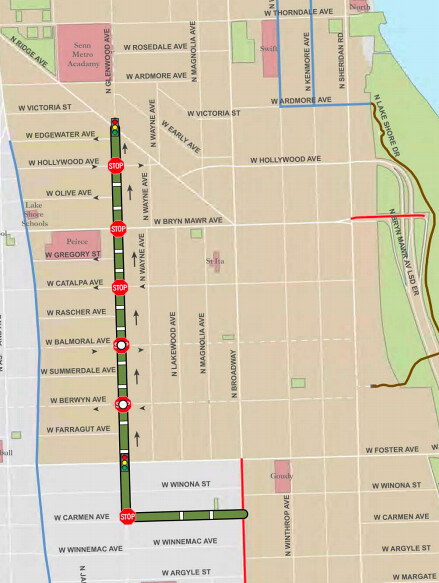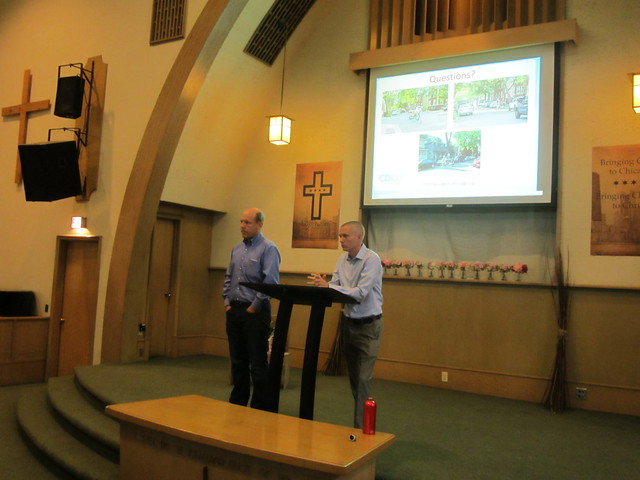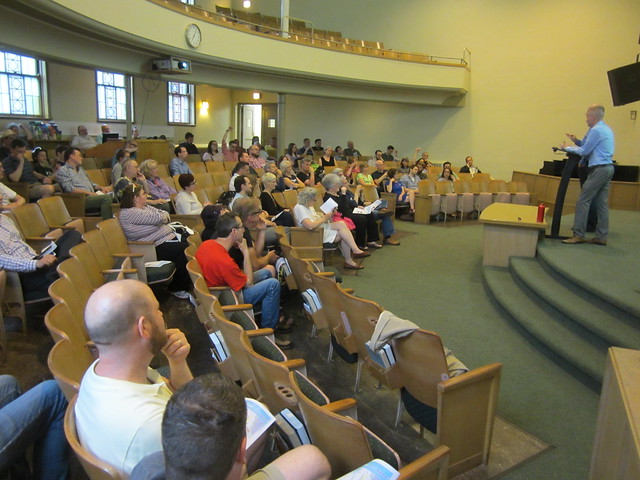Once in while, the Chicago Department of Transportation has a bikeway idea that’s so good, I wish that I’d thought of it first. Such is the case with the proposed Glenwood Avenue Neighborhood Route. This neighborhood greenway would run for 0.75 miles on Glenwood between Ridge and Carmen, and on Carmen for 0.25 miles between Glenwood and the Broadway buffered bike lanes. The project is expected to cost no more than $75,000, and CDOT hopes to install it later this summer.
The greenway would greatly improve the southbound route options from Rogers Park and northern Edgewater to Andersonville and Uptown. Currently, northbound cyclists can access Glenwood from Clark or Broadway via Argyle, just north of St. Boniface Cemetery.
Glenwood is a serene, leafy residential street that leads all the way to Rogers Park, providing a great alternative to the high-speed, four-lane stretches of Broadway north of Foster, and Clark north of the Andersonville retail district. The later stretch is designated as a recommended route on the Chicago Bike Map, but it really shouldn’t be, since speeding is common there.
However, southbound cyclists can’t legally make the whole trip on Glenwood because the street is one-way northbound between Ridge and Foster. I generally deal with this by heading west on Edgewater Avenue, located just south of Glenwood/Ridge, and continuing south on Clark along Andersonville business strip. That’s a reasonably bikeable stretch of Clark, but it’s probably a bit too hectic and stressful for less confident riders and families.
Many cyclists are already currently choosing to ride against traffic on Glenwood. Census data shows that four to seven percent of residents along the corridor bike to work, which is several times higher than the city average. CDOT counted up to 40 bicyclists an hour on the corridor during peak hours, representing 25 percent of traffic, with more than half of the cyclists riding against traffic.
Perhaps partly because drivers aren’t expecting southbound bike traffic on the northbound stretch of Glenwood, six bicyclists were injured in crashes there between 2009 and 2013. Half of them were under age 18.
CDOT plans to legalize southbound bike riding on the northbound segment of Glenwood by adding a contra-flow bike lane. The lane will be painted green near intersections to give motorists an additional heads-up, and shared-lane marking will be added for northbound bike traffic. Carmen, which is already two-way, will get shared lane markings in both directions. Stop signs and stop bars, and possibly bike traffic signals, will be installed for southbound cyclists.
The narrower travel lane for cars on northbound Glenwood will help calm traffic, and bike-friendly sinusoidal speed humps may be added as well. High visibility, zebra-striped crosswalks will be added, and other crosswalks will be refreshed. No parking will be eliminated. Therefore, the greenway is really a win for everyone involved: bicyclists, pedestrians, motorists, and neighboring residents.
Unfortunately, not everyone present at a community meeting last night at Edgewater Baptist Church saw it that way. After 48th Ward Alderman Harry Osterman and CDOT’s Mike Amsden gave a presentation on the proposal, the floor was opened to comments. A number of drivers said they fear that encouraging contra-flow bike traffic will lead to more crashes and argued that the project is a waste of money. “I have a problem spending $75,000 catering to someone who’s breaking the law,” said one man.
Osterman and Amsden pointed out that making the already-prevalent southbound bike traffic legal and predictable, the greenway will improve safety. They noted that contra-flow bike lanes have already been put in nearby on Albion, Berteau, and Ardmore, with few or no bike crashes – none of them serious -- reported at any of these locations since installation. A neighborhood greenway with a contra-flow lane was also installed last year on Wood Street in Ukrainian Village and Wicker Park.
Another naysayer gave a perfect-storm rant against complete streets project, decrying the Broadway road diet, speed humps and traffic circles, which he called “suicide circles.” (“They’re only suicidal if you don’t slow down,” noted a fellow attendee.) He groused that non-drivers don’t pay their fair share of infrastructure costs (correct, they pay more than their fair share.) “It comes from my tax money, and what do I get for it? I’m going to get bicycle lanes in front of my house now?”
However, judging from applause, the majority of the crowd supported the greenway. Annie Feldmeier Adams, who lives just west of Glenwood, said that she also owns a car and pays taxes, but usually gets around by bike. She said that when she moved to the neighborhood ten years ago, she noticed a lot of contra-flow bike traffic. “I couldn’t figure it out and it was driving me nuts,” she said. Then she realized that these cyclists were simply trying to avoid dangerous conditions on the main streets. She told Osterman and Amsden, “You guys are just trying to correct what is already happening, and I really appreciate it.”
A young boy told the crowd that he bikes south to school everyday via Glenwood. “It’s nuts at Ridge,” he said, noting that he currently has to ride southeast on the Ridge sidewalk, and then head south on Wayne, the next side street east of Glenwood. “The speed humps are a good idea too,” he added. “Especially during the summer, people fly down the street.”
Kyle Smith, who lives near Hollywood and the lake, says he’s tried all kinds of routes to get to his job in Wicker Park and has determined that riding the wrong way on Glenwood for a stretch is his safest option. “I hate it and the drivers hate it,” he acknowledged, but said he’s noticed several other cyclists who also do this on a daily basis. “Legalizing the route that people are already taking is nothing but a good idea."







